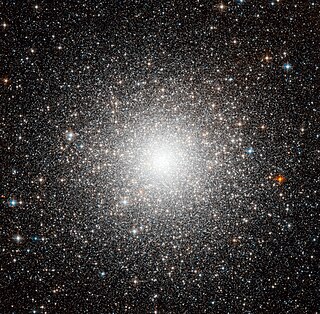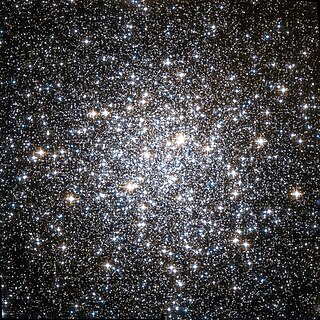
Messier 5 or M5 is a globular cluster in the constellation Serpens. It was discovered by Gottfried Kirch in 1702.

The Sagittarius Dwarf Spheroidal Galaxy (Sgr dSph), also known as the Sagittarius Dwarf Elliptical Galaxy, is an elliptical loop-shaped satellite galaxy of the Milky Way. It contains four globular clusters in its main body, with the brightest of them – NGC 6715 (M54) – being known well before the discovery of the galaxy itself in 1994. Sgr dSph is roughly 10,000 light-years in diameter, and is currently about 70,000 light-years from Earth, travelling in a polar orbit at a distance of about 50,000 light-years from the core of the Milky Way. In its looping, spiraling path, it has passed through the plane of the Milky Way several times in the past. In 2018 the Gaia project of the European Space Agency showed that Sgr dSph had caused perturbations in a set of stars near the Milky Way's core, causing unexpected rippling movements of the stars triggered when it moved past the Milky Way between 300 and 900 million years ago.

Messier 2 or M2 is a globular cluster in the constellation Aquarius, five degrees north of the star Beta Aquarii. It was discovered by Jean-Dominique Maraldi in 1746, and is one of the largest known globular clusters.

Messier 15 or M15 is a globular cluster in the constellation Pegasus. It was discovered by Jean-Dominique Maraldi in 1746 and included in Charles Messier's catalogue of comet-like objects in 1764. At an estimated 12.5±1.3 billion years old, it is one of the oldest known globular clusters.

Messier 30 is a globular cluster of stars in the southeast of the southern constellation of Capricornus, at about the declination of the sun when the latter is at December solstice. It was discovered by the French astronomer Charles Messier in 1764, who described it as a circular nebula without a star. In the New General Catalogue, compiled during the 1880s, it was described as a "remarkable globular, bright, large, slightly oval." It can be easily viewed with a pair of 10×50 binoculars, forming a patch of hazy light some 4 arcminutes wide that is slightly elongated along the east–west axis. With a larger instrument, individual stars can be resolved and the cluster will cover an angle of up to 12 arcminutes across graduating into a compressed core about one arcminute wide that has further star density within.

Messier 54 is a globular cluster in the constellation Sagittarius. It was discovered by Charles Messier in 1778 and then included in his catalog of comet-like objects.

Messier 53 is a globular cluster in the Coma Berenices constellation. It was discovered by Johann Elert Bode in 1775. M53 is one of the more outlying globular clusters, being about 60,000 light-years (18.4 kpc) light-years away from the Galactic Center, and almost the same distance from the Solar System. The cluster has a core radius (rc) of 2.18 pc, a half-light radius (rh) of 5.84 pc, and a tidal radius (rtr) of 239.9 pc.

Messier 56 is a globular cluster in the constellation Lyra. It was discovered by Charles Messier in 1779. It is angularly found about midway between Albireo and Sulafat. In a good night sky it is tricky to find with large (50–80 mm) binoculars, appearing as a slightly fuzzy star. The cluster can be resolved using a telescope with an aperture of 8 in (20 cm) or larger.

Messier 70 or M70, also known as NGC 6681, is a globular cluster of stars to be found in the south of Sagittarius. It was discovered by Charles Messier in 1780. The famous comet Hale–Bopp was discovered near this cluster in 1995.

Palomar 1 is a globular cluster part of the Palomar group in the constellation Cepheus in the halo possibly in the Outer Arm of the Milky Way galaxy. First discovered by George O. Abell in 1954 on the Palomar Survey Sky plates, it was catalogued as a globular cluster. At 6.3 to 8 Gyr, it is a very young cluster when compared to the other globular clusters in the Milky Way. It is a relatively metal-poor globular with [Fe/H] = -0.60. It is likely that Palomar 1 has a similar evolutionary history to the Sagittarius dwarf companion globular Terzan 7, that is, it may have once been associated with a dwarf spheroidal galaxy that was later destroyed by tidal forces.

NGC 5986 is a globular cluster of stars in the southern constellation of Lupus, located at a distance of approximately 34 kilolight-years from the Sun. It was discovered by Scottish astronomer James Dunlop on May 10, 1826. John L. E. Dreyer described it as, "a remarkable object, a globular cluster, very bright, large, round, very gradually brighter middle, stars of 13th to 15th magnitude". Its prograde–retrograde orbit through the Milky Way galaxy is considered irregular and highly eccentric. It has a mean heliocentric radial velocity of +100 km/s. The galacto-centric distance is 17 kly (5.2 kpc), which puts it in the galaxy's inner halo.

NGC 6723 is a globular cluster in the constellation Sagittarius. Its magnitude is given as between 6 and 6.8, and its diameter is between 7 and 11 arcminutes. It is a class VII cluster with stars of magnitude 14 and dimmer. It is near the border of Sagittarius and Corona Australis.

NGC 6934 is a globular cluster of stars in the northern constellation of Delphinus, about 52 kilolight-years distant from the Sun. It was discovered by the German-born astronomer William Herschel on 24 September 1785. The cluster is following a highly eccentric orbit through the Milky Way along an orbital plane that is inclined by 73° to the galactic plane. It may share a common dynamic origin with NGC 5466. As of 2018, it has been poorly studied.

NGC 2808 is a globular cluster in the constellation Carina. The cluster belongs to the Milky Way, and is one of our home galaxy's most massive clusters, containing more than a million stars. It is estimated to be 12.5-billion years old.

Terzan 7 is a sparse and young globular cluster that is believed to have originated in the Sagittarius Dwarf Spheroidal Galaxy and is physically associated with it. It is relatively metal rich with [Fe/H] = -0.6 and an estimated age of 7.5 Gyr. Terzan 7 has low levels of nickel which supports its membership in the Sag DEG system since it has a similar chemical signature. It has a rich population of blue stragglers that are strongly concentrated toward the center of Terzan 7. It has an average luminosity distribution of Mv = -5.05. It has a half-light radius (Rh) of 6.5pc.
Palomar 14 is a globular cluster located in the constellation Hercules. It is a member of the Palomar Globular Clusters group. Palomar 14 was discovered in 1958 by Sidney van den Bergh and Halton Arp during inspection of the photographic plates from the Palomar Sky Survey. This is a round, diffuse cluster located in the outer halo of the Milky Way galaxy. It is about 3–4 billion years younger than a typical galactic cluster.

Palomar 6 is a loose globular cluster in the constellation Ophiuchus that belongs to the Milky Way galaxy. It is a member of the Palomar Globular Clusters group. It is located about 25,000 light-years away from the Sun. It formed in what would become the bulge of the Milky Way. It is similar to other old-bulge globular clusters such as Messier 62, NGC 6522, NGC 6558, and Haute-Provence 1.

NGC 4147 is the New General Catalogue identifier for a globular cluster of stars in the northern constellation of Coma Berenices. It was discovered by English astronomer William Herschel on March 14, 1784, who described it as "very bright, pretty large, gradually brighter in the middle". With an apparent visual magnitude of 10.7, it is located around 60,000 light years away from the Sun at a relatively high galactic latitude of 77.2°.

NGC 6441 is a globular cluster in the southern constellation of Scorpius. It was discovered by the Scottish astronomer James Dunlop on May 13, 1826, who described it as "a small, well-defined rather bright nebula, about 20″ in diameter". The cluster is located 5 arc minutes east-northeast of the star G Scorpii, and is some 43,000 light-years from the Sun.

NGC 5053 is the New General Catalogue designation for a globular cluster in the northern constellation of Coma Berenices. It was discovered by German-British astronomer William Herschel on March 14, 1784 and cataloged as VI-7. In his abbreviated notation, he described it as, "an extremely faint cluster of extremely small stars with resolvable nebula 8 or 10′ diameter, verified by a power of 240, beyond doubt". Danish-Irish astronomer John Louis Emil Dreyer reported in 1888 that the cluster appeared, "very faint, pretty large, irregular round shape, growing very gradually brighter at the middle".





















